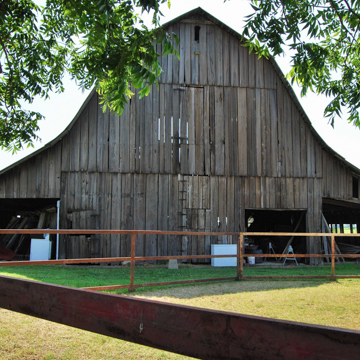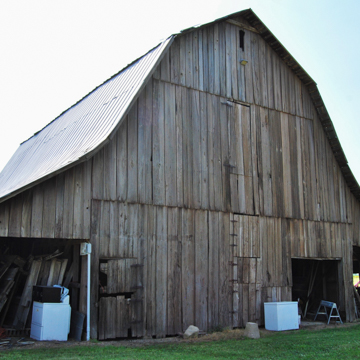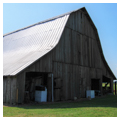When Paul and Mary Pfeiffer (see CY1) divided their 63,000 acres of land in Clay County into 40- and 80-acre tenant farms, they advertised for experienced white farmers, preferring to recruit from the Midwest. Each family was provided with a house, hay and mule barns, an outhouse, a pump house, a smokehouse, and sheds for livestock. Pfeiffer’s work crew built the houses and farm buildings, including this hay barn and corn crib, the only structures that still stand as originally built. They were constructed according to building and framing techniques illustrated in the farm management pamphlets distributed by land-grant universities. The hay barn is built of local cypress, left unpainted, and has a gambrel roof supported on wooden trusses. For the corn crib, the planks were laid one inch apart, which, with additional open space under the cypress roof, allowed air to circulate and help dry the corn to prevent mold. Called a “rent crib,” the structure is laid out like a dogtrot house, and when the load of corn is driven between the cribs, two shovel loads of corn went into the farmer’s crib and one shovel load into the rent crib to pay the year’s rent. In 1929, Paul Pfeiffer established the Piggott Land Trust Company, which made it possible for the farmers to buy their land. This was during the Great Depression, when many people in the Delta were being evicted from their land and mechanization was driving even more away. After Paul Pfeiffer died in 1944, his son Karl took over the leadership of the Land Trust, and by 1954 he had sold the last of the acreage to the sharecroppers.
You are here
Rouse-Richardson-Pfeiffer Hay Barn and Corn Crib
c. 1930. Clay County Rd. 533, 0.25 miles south of County Rd. 548, 1.5 miles southeast of Piggott
If SAH Archipedia has been useful to you, please consider supporting it.
SAH Archipedia tells the story of the United States through its buildings, landscapes, and cities. This freely available resource empowers the public with authoritative knowledge that deepens their understanding and appreciation of the built environment. But the Society of Architectural Historians, which created SAH Archipedia with University of Virginia Press, needs your support to maintain the high-caliber research, writing, photography, cartography, editing, design, and programming that make SAH Archipedia a trusted online resource available to all who value the history of place, heritage tourism, and learning.







